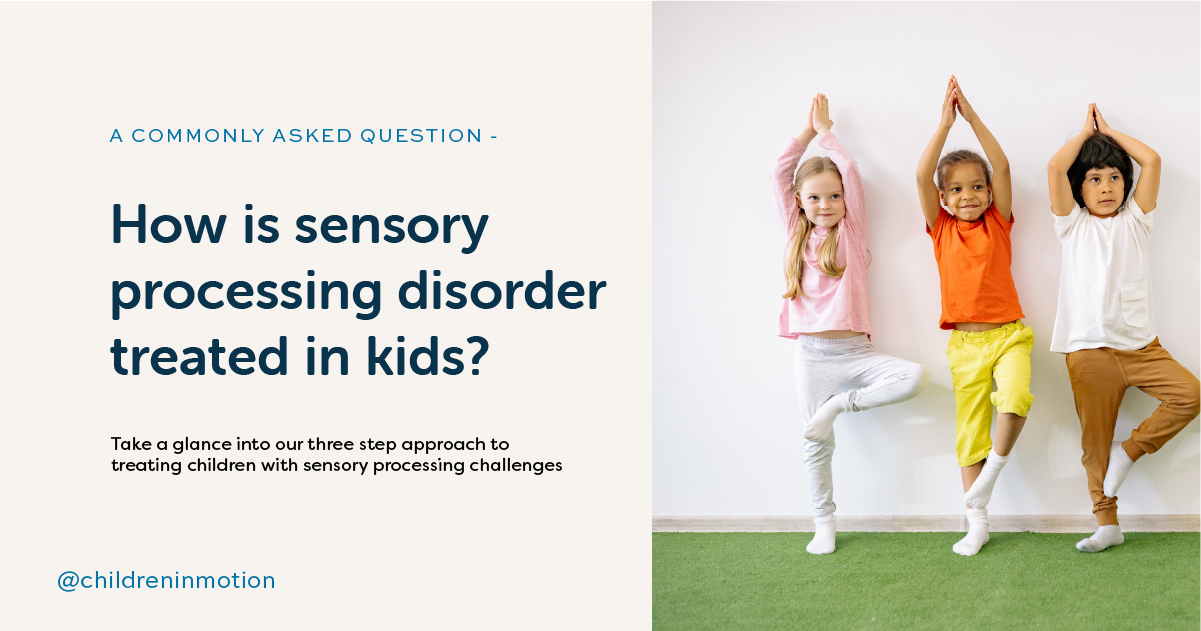January 18, 2024
How is sensory processing disorder treated in kids?
Frequently we are asked ‘How is sensory processing disorder treated in kids’. After hundreds of hours in the clinic with sensory kiddos, we have established a strategic method for treating children who are experiencing sensory processing challenges. Each child is unique & requires their own individualized support, but using our three pronged approach we are able to help our clients achieve their goals and be successful in their daily lives. Once we have completed the evaluation process & confirmed there are indeed sensory processing challenges, the way we address these challenges at Children In Motion revolves around a three-pronged approach-
Step One – Educate the parents/caretakers about sensory processing
During the initial review of the evaluation, & in the first few visits, we focus on familiarizing parents with the basic concepts of sensory processing. We want them to understand how the brain processes sensory information, so that they can understand why their child responds to sensory information the way that they do. We do this by providing parent education during visits, sharing resources we have created related to sensory processing, & offering book recommendations when appropriate.
Once my parents have an understanding of these foundational concepts & how they apply to their child’s unique mind body system, they will be able to see their child through a different lens & understand them better. Having an understanding of sensory processing also helps with implementing what we work on in the clinic into practice everyday.
Step Two – Make environmental adjustments
In the second prong of our approach we identify ways to scaffold, or protect, the child’s environment to foster success with their current skill set while we work on creating long term solutions in therapy. Right off the bat I usually tell all of my clients to start prioritizing three things – consistently getting a good night’s sleep, staying well fed, and leaving more than enough time for transitions.
If your child is having a hard time getting consistent sleep, perhaps we experiment with using a weighted blanket*, or a sound machine* to cancel out distracting noises. Are transitions really tough? Let’s make sure there is plenty of time in the schedule to transition, and utilize animal walk cards (to get muscle work in) or visual reminders to help with the process. If your child struggles to sit long enough at the table to get a good meal in, maybe start incorporating more muscle work before dinner or utilize a wobble cushion*.
The same idea goes for other sensory quirks that your child may have. For example, if your child is sensitive to sound, ensure that it is quiet when they are doing homework or that they have noise canceling headphones for noisy environments. Prioritizing these seemingly small adjustments can make a difference in the short term, maximize the time spent inside of treatment sessions, and help build long term habits to support your sensory kiddo.
Step 3 – Rewire the brain through therapeutic experiences
This is where the magic really happens! Occupational therapists who have specialized training in sensory processing understand how to rewire default processing skills by using movement, muscle work, & tactile experiences to create powerful treatment sessions which reinforce new neural pathways that lead to new processing skills.
This method of therapy is called ‘Sensory Integration Therapy (SI)’. We utilize equipment in our sensory gym to facilitate sensory experiences where our clients can safely build their skills without shutting down or losing control. We love using our rock wall, sensory swings, and ball pit during treatment sessions. Based on the report from the initial evaluation, our team knows exactly which sensory systems to target & which strategies or activities to incorporate into therapy sessions to improve processing (learn more about our approach with SI here).
Following our three pronged approach we are able to help our clients improve their sensory processing & thrive in their everyday lives. It’s important to note that this process is a learning process. When we work with families we are constantly making adjustments as we uncover clues that help us fine tune our therapy plan. If you are new to the sensory world & looking for resources, I encourage you to check out our free resource library & download The Sensory Processing Crash Course.
*Affiliate link

back to blog home